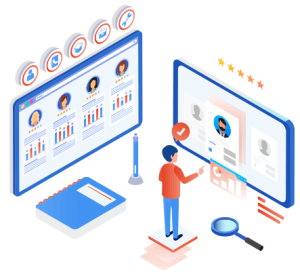Exploring Bias in AI Recruiting Systems
By Marque Green | March 2, 2022
Recruiting management systems are widely utilized today by most employers to automate several aspects of the recruiting process, particularly for medium and highly skilled roles. In the 1980’s and 1990’s, digital job postings and resume-scanning software were originally created to make it easier for job seekers to apply for jobs and employers to manage their applications from a larger pool of applicants. AI recruiting and talent management tools have disrupted and reshaped job seeking and hiring processes resulting in inefficiency as well as creating a class of “hidden workers” whose talent remains unrecognized. Automated tools spotlight formal education, employment continuity and keywords at the expense of any attempt to recognize the humanity of the applicant.

Source:streebo
Initially both job applicants and employers felt these systems were largely beneficial. Hosting job postings online can make applying for jobs more accessible and equitable as they are available to the public. Employers also saw an increase in the average number of applications per job posting. In the early 2010s, a job posting would yield about 120 applicants on average. With the increase of these recruiting systems, by the end of 2010s, companies were seeing job postings yield about 250 applicants on average.[3] Due to this gain in applicants, companies found these technologies were leading to larger and more diverse candidate pools. An additional benefit with these systems is it allows for employers to find candidates with highly specialized skills by keyword matching. This has led to more targeted candidates for highly skilled jobs. Finally, these systems have led to productivity gains within talent acquisition teams.
Unfortunately, recruiting management systems do lead to unintended harms for both employers and job applicants. Despite digital job postings leading to more job applicants, very few (about 4 to 6 on average) make it beyond the AI resume-scanning software that often discriminates via arbitrary selection and evaluation criteria. For example, this software tends to focus on what candidates don’t have rather than the value and capacities they bring to a company. Specifically, hospitals who only accepted candidates with experience in “computer programming” on their CV, when all they needed were workers to enter patient data into a computer [3]. AI resume-scanning software oversimplifies what criteria make a candidate good or bad and can quickly reject candidates on biased criteria. Often candidates are rejected for failing to meet specific criteria without considering their other qualifications. The shortcomings of these systems are well known. Among executives interviewed by Harvard for a study on common recruiting processes, 90% admitted they knew automated recruiting software was mistakenly filtering out viable candidates but fixing these problems would require a complete overhaul of the recruiting and hiring process [4].
Since recruiting management software rejects and excludes most candidates, there has been a new class of worker created known as the “hidden worker”. These are individuals who are able and willing to work but remain locked out by structural problems within the recruiting process like requiring traditional qualifications and continuous employment.

Source: NextAvenue
Hidden workers tend to be caregivers, veterans, immigrants, those with physical disabilities, less-advantaged populations, or those who lack traditional qualifications. Resume-scanning software unfairly penalizes someone who has gaps in their employment or who lack traditional education credentials without considering the applicant’s other qualifications. Consequently, millions of ready and able workers are unfairly excluded from the job market.
How can we strive to make recruiting management software fairer and more equitable? First, talent acquisition teams and hiring managers should refine job descriptions. Instead of focusing on finding the “perfect candidate”, hiring teams should focus on identifying critical skills and create descriptions that accurately reflect the skills needed to do the job. AI has the potential to enable companies to understand the background of their current employees and determine what variables correlate to their success. Additionally, AI systems should shift from negative to affirmative filters, focusing on the applicant’s strengths instead of highlighting weaknesses. As recruiting management systems continue to grow and evolve, employers have a responsibility to reduce systemic bias and create more equitable recruiting processes. By refocusing away from traditional measures of success toward evaluating desired skills and competencies, the recruiting and hiring process can become more equitable and efficient for job seekers and employers of any sort.
References:
[1] Automate and Manage a Recruitment Management Process for Your Organization. Streebo https://www.streebo.com/recruitment-management-system
[2] Kerry Hannon. What’s Keeping Family Caregivers and the Long-Term Unemployed from Getting Hired. Next Avenue https://www.nextavenue.org/hidden-workers-ai-getting-hired/
[3] James Vincent. Automated hiring software is mistakenly rejecting millions of viable job candidates. Next Avenue https://www.theverge.com/2021/9/6/22659225/automated-hiring-software-rejecting-viable-candidates-harvard-business-school
[4] Fuller, Raman, Sage-Gavin, Hines. Hidden Workers: Untapped Talent. Harvard Business Review https://www.hbs.edu/managing-the-future-of-work/Documents/research/hiddenworkers09032021.pdf
